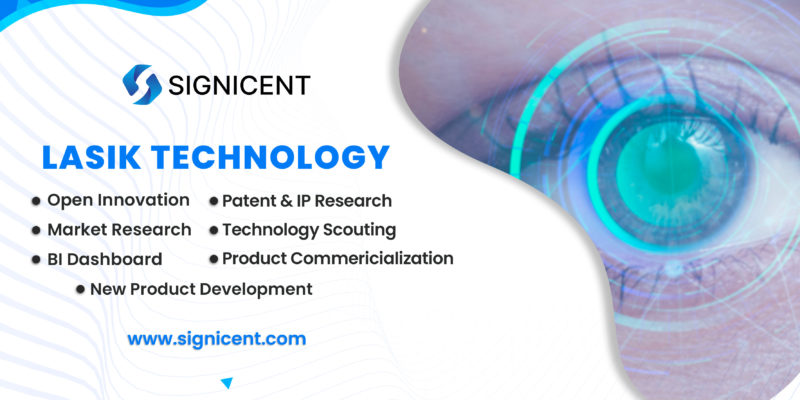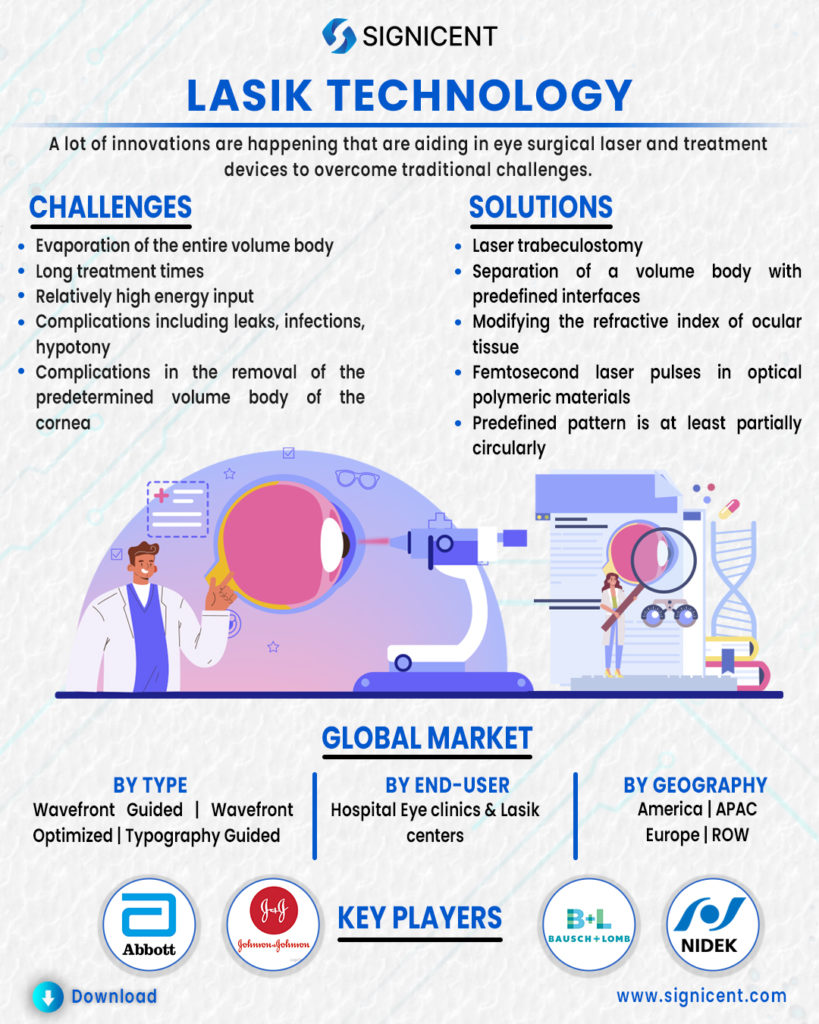The LASIK technology report explores the LASIK for Eyecare System. The report would cover technological advancements and innovations in the LASIK for Eyecare System. Also, the identification of transformative players working in these technological areas from a global perspective. Additionally, the competitive perspective along with market analysis has been summarised. Some light is shed on the future direction of the LASIK for Eyecare System.
Innovation in LASIK Technology
In this section of the LASIK technology report, the innovations that are aiding in eye surgical laser and treatment devices have been briefly discussed.
At present, the devices and methods for controlling a photo ablative ophthalmologic laser cause the evaporation of the entire volume body. This requires relatively long treatment times, on the one hand, a relatively high energy input by the laser into the cornea also gets affected. In particular, the latter can result in complications in the removal of the predetermined volume body of the cornea.
Predefined Interfaces
The object of the present invention is to provide a method and a treatment device for controlling an eye surgical laser for the separation of a volume body with predefined interfaces from a human or animal cornea. of a human or animal eye by means of photo-disruption and at least one control device for the laser or lasers as well as to a computer program, a computer-readable medium, and a method for the separation of a volume body with predefined interfaces from a human or animal cornea.
Predefined Pattern
The laser is controlled such that the predefined pattern is at least partially circularly and/or spirally ablated. The start of the photo disruption can be affected by the individual laser pulses in the center of the respective interface or also at the edge of the respective interface. The predefined pattern is defined based on one or more control datasets, wherein the control dataset or datasets include control data for positioning and/or for focusing individual laser pulses in the cornea.
Invasive Eye Surgeries
Highly invasive eye surgeries create huge openings which can cause many complications including leaks, infections, hypotony (e.g. low eye pressure) and require post-operative, long-term monitoring to avoid late complications. In minimally invasive laser surgeries the surgeon may have some view of the target but have to rely on external light sources.
Laser trabeculostomy
The laser probe of the present invention is particularly well suited for a laser trabeculostomy procedure so that the surgeon has a clear field of view within the eye, particularly of the anterior chamber angle where the cornea and the iris meet so that the position of the laser relative to the trabecular meshwork can be clearly visualized.
The laser probe includes a fiber optic core and an illumination member for transmitting laser energy and providing illumination in a field of view proximate to the delivery tip of the fiber core respectively.
Vision Correction
There is an ongoing need for new and improved techniques and materials, and refractive corrector vision components resulting therefrom, for improving human vision. Current LASIK corneal treatments cannot create sharp edges as they are both formed with larger laser spot sizes and then have the cornea and/or epithelium healing over the surface ablations and flaps, thereby causing a change in the resulting corneal correction.
Laser-Induced Refractive Index
The laser-induced refractive index changes by focused femtosecond laser pulses in optical polymeric materials or optical tissues are performed to address various types of vision correction. Improving binocular visual performance in a presbyopia patient, comprising: modifying the refractive index of ocular tissue of an eye of the patient, by irradiating select regions of the ocular tissue with a focused, visible, or near-IR laser below the optical breakdown threshold of the tissue to provide refractive structures that exhibit a change in refractive index.
Laser-induced refractive index changes by focused femtosecond laser pulses in optical polymeric materials or optical tissues are performed to address various types of vision correction. Modifying the refractive index of the ocular tissue of the eye of the patient, by irradiating select regions of the ocular tissue with a focused, visible, or near-IR laser below the optical breakdown threshold of the tissue to provide refractive structures that exhibit a change in refractive index.
Key Players In LASIK Technology
Signicent consistently track changes in the innovations and market in LASIK technology. Our experience and understanding of the area can help better R&D, help solve the bottleneck, find suppliers and understand the state of art search.
LASIK technology report hereby enlists the key players that are comprehensively working on LASIK technology. Some of the key players in LASIK Products & Systems are Johnson & Johnson, Bausch & Lomb, Alcon Novartis company, Zeiss, Schwind eye tech solutions, NIDEK CO. LTD, Ziemer Ophthalmic Systems, and others.
Abbott is founded in the year 1888 and it sells medical devices, diagnostics, branded generic medicines, and nutritional products. It split off its research-based pharmaceuticals business into AbbVie in 2013. Among its well-known products are the medical devices, diagnostics, and nutrition product divisions.
Each year Signicent provides consultancy to hundreds of organizations to help transform their innovations to value.
Transformative Companies (Start-ups) In LASIK
In this section of the LASIK technology report, the transforming companies are enlisted to understand the market dynamics.
- Keranova is a start-up evolving in the field of innovative medical technologies. It has a revenue of <$5 Million that designs and develops surgical equipment for the operating room intended for various ophthalmological indications of the anterior segment of the eye.
- Belkin vision received €17.5M from the EU Innovation Council and BELKIN Vision completed its first-in-human clinical trial. Presently they are focusing on commercializing the sight-saving technology to help millions of people around the world suffering from glaucoma.
- Nayam Innovations are working on Optical system design and evaluation using advanced simulations and algorithms.
Global LASIK Products
LASIK technology report also has information about market trends, market dynamics, and market segmentation. The market has been divided into various segments based on
- By Type, wavefront-guided, wavefront-optimized, and topography-guided.
- By end-user, Hospitals Eye Care Clinics, and Lasik centers.
- By Geography, America, APAC, Europe, and RoW.
By type, LASIK instruments form the largest and fastest-growing product segment in this market. The growth of this segment is primarily driven by the rising incidence of HAIs, the increasing number of surgeries performed, stringent regulatory mandates for infection control, and the growth in the medical device and Medical industries.
Based on end-user, the hospitals & clinics segment accounted for the largest share of the Eyecare equipment market in 2020. The large share of this segment can be attributed to the increasing incidence of Eye factors, the growing number of hospitals in Asian countries, the growing volume of surgical procedures performed, and the increasing government initiatives.
North America dominates the sterilization equipment market. The European market is the second-largest shareholder in the global sterilization equipment market, followed by North America. In 2020, North America was the largest regional market for Eyecare equipment. The growing demand for LASIK technologies from the healthcare industry, the increasing number of surgical procedures performed, and the presence of key players in the region are the major factors supporting the growth of the Eyecare equipment market in North America
Asia-Pacific is expected to grow at the fastest CAGR during the forecast period. The factors driving the growth of the Asia-Pacific market are accelerated economic growth, growing government focus on the healthcare sector.
Emerging economies such as India, China, Brazil, Russia, and countries in Latin America and Southeast Asia are expected to provide significant growth opportunities to players operating in the Eyecare equipment market. Over half the world’s population resides in India and China, making these markets home to a large patient population.

